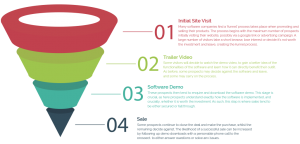The Key Ingredients Behind Successfully Marketing a Software Company
While software is a crucial part of business life, it can be difficult to know how best to present it to your potential customers. At GMA, we’ve worked with a large number of software companies over the years – here are a few advanced marketing techniques we’ve found that can greatly enhance a company’s exposure to the public and their subsequent sales.
Landing Page vs Website
Your website isn’t always the best place to send your potential customers. While your website may contain everything someone might need to know about your product or services, that can be a curse as much as it is a blessing. Access to dozens or even hundreds of other pages is sometimes a distraction from your call to action, whether you’re aiming for your customers to sign up, contact you, or buy from you. The power of a landing page is its cleverly structured funnel layout, which – if organised correctly – will lead your customer down a path designed to give them everything they need to answer your call to action, from demo videos to statistics to your most appealing copy.
Landing pages are also uniquely trackable. While your homepage may have visitors coming from all sorts of different sources, including search engine results and links from other websites, your landing page is a clean slate. Without inside interference, you can track how many visitors you’re receiving from your landing page’s promotional campaign, as you link to it in your latest email campaign or press release.
Homepage Layout is Critical
We find the large majority of software companies that contact us for marketing have their own website featuring a homepage or landing page, but it will often be lacking in informative and audience-capturing information. It is crucial that the homepage carries the all-important details about the company and product, allowing potential customers to instantly engage with the software. We’ll frequently read a whole page of text about a product without picking up on what it actually does – so make sure this is communicated in clear terms near the top of the page, with further information, features and benefits cascading down the remainder of the page.
Focus on the Advantages
Over the years we’ve gathered a huge amount of experience in marketing software companies. As a general rule, potential end-users of the products first and foremost want to know exactly how the product will benefit them directly. Depending on the software you’re advertising, this can be a pretty dense subject, so we recommend a two-minute introducer video as an effective method in capturing a prospect’s attention. The video has to be short, simple, effective, and direct, and should demonstrate the software’s USP and how it benefits the end-user – whether by saving on costs, improving company efficiency, and/or enhancing the quality of products/services altogether.
Make the Benefits Clear!
Information on every aspect of the software’s functions and abilities should be easily accessible in your marketing collateral. This is often not the case – we find many software websites are cluttered or disorganised, with many software features hidden on sub-pages or not promoted at all. Your potential customers will be decision makers, and as such will be looking for precise information on how the product can be implemented and how it can be beneficial for their business, along with how much it’s going to cost them – so this information needs to be available upon arrival and ideally positioned near the top of the landing page.
Ensure that the benefits of the software are tangible and don’t be afraid to drop stats – it’s far easier to flat-out state that the software could reduce your admin time by 45% than to exhaustively list its capabilities. We most frequently find that prospects will be looking to improve their productivity, quality, cost reduction and simplicity. Try coming up with a few real-world improvements your users could enjoy.
Aim to prioritise a clear explanation of how the product works and how beneficial it can be, before guiding visitors to the prices.
Digitally Delivered Marketing Drives Downloads
A lot of the software companies who come to us for help with their marketing strategy often have plain and outdated websites, which do not explain or display their product effectively. Because software is inherently interactive, the related website and additional content should ideally follow suit. The option to view and sample the intricacies of the software easily will engage potential customers more effectively than static text and screenshots.
An on-demand menu structure helps users access the important information they want to see quickly, without getting lost on the website. The most successful interactive websites with slick interfaces allow potential customers to view, sample, and download the product quickly and easily, without the need for human interaction.
Action Speaks Louder
Many companies attempt to use screenshots to demonstrate their software’s capabilities – however these struggle to justify the functionality of the software, these techniques are essentially useless in marketing the product.
Software demos tend to fall into two categories. Narrated video tours can show the functionality of the application, whilst a free software trial with a dummy database can allow prospects to experience the product first-hand without cost.
Offering potential customers an opportunity to trial software gives them opportunity to see how beneficial it can be, significantly increasing their interest in the product and subsequently improving the chance of a sale!
Software demos should aim to display the key benefits of the product, but also limit certain features as to entice the prospect into purchasing the full product.
A Follow-Up Call Can Go a Long Way
In our experience, we’ve found that following up a free trial with a personal phone call can increase sales dramatically. At this stage, any issues or enquiries about the product can be addressed. A content customer is always more likely to make a purchase!
Additionally, webinars can be offered to help the user get the best out of the product. Webinars can be used as a platform for sales pitches to any organisation across the planet, without the need to physically travel to their premises – saving time and money for both parties.
The Sales Funnel



